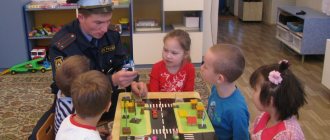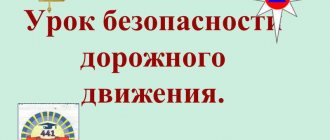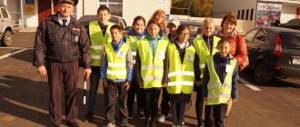Didactic games on environmental education
Didactic games on environmental education for preschool children
What is harmful and beneficial for nature (water)?
(A game with punched cards.)
Goals:
Draw children's attention to man's relationship to natural objects (water). Establish rules of behavior in nature. Foster respect for water.
Material:
Punch cards that depict human actions that harm nature (water) and the use of water for useful purposes.
Game action:
Mark with various signs (for example, different colors or shapes) the positive and negative impacts of humans on nature (water).
Lotto “Who needs water?”
Target:
־ To consolidate children’s knowledge about the importance of water in human life, animal and plant life.
־ Exercise children in classifying plants, animals, birds.
־ Develop logical thinking, memory and attention.
־ Build perseverance and desire for independence.
Material:
— Playing fields 20x25 (5 pieces), divided into squares. In the center of the playing field there is an image, around which there are 8 empty squares. Images: “Who lives in water?”; “Who lives by the water?”; “Who drinks water?”; “What do you pour water on?”; “What grows in water?”
— Cards measuring 6x6 cm, with images of animals, insects, people, birds, plants.
Progress of the game:
Option 1.
From 1 to 5 children can take part in the game.
The presenter distributes playing fields to the participants of the game - cards measuring 20x25, which depict: “Who lives in the water?”; “Who lives by the water?”; “Who drinks water?”; “What do you pour water on?”; “What grows in water?” Cards, 6x6 cm in size, with images of animals, insects, people, birds, plants are kept by the presenter. The presenter mixes them and, taking them out one at a time, shows them to the children, clarifying the questions: “Who is this? Who needs this card? The player names what is shown on the card and why he chose it.” (For example, “It’s a cat. She’s drinking water.”) If the answer is correct, the presenter gives the card to the player, and he places the picture on his playing field.
The game continues until all participants in the game match the cards to the playing fields. The first one to fill his playing field with cards wins.
Option 2. "
Confusion". From 1 to 5 children can take part in the game. The presenter offers the players cards with incorrectly filled in fields. Players must correct the error.
Recommendations for the use of didactic games in the practice of preschool educational institutions:
The game can be used when organizing activities with children in educational areas - “Cognition”, “Communication”, “Socialization”.
"Mysterious men"
Program content.
Introduce children to the fact that water can be in a solid, liquid, or gaseous state. Learn to build a model of any specific object or even a plot using “little men”.
Give children knowledge about inanimate nature and elements of physics. To develop in children such qualities as inquisitiveness, curiosity, mental activity and imagination.
Material.
Cards depicting water in various states of aggregation (solid, liquid and gaseous) - ice, snowflake, juice, milk, steam; cards with images of “human” models characterizing states of aggregation - (demonstration and handout).
Progress of the game.
The game can be played by 3-5 people.
The teacher offers the children a set of cards depicting models of men that symbolize the state of water: liquid, solid and gaseous. And also cards with images of various objects: ice, water, snowflakes, steam, a glass of juice, orange, etc. Explains that any object can be depicted schematically, using models.
The teacher invites the children to find all solid objects. Why are these objects hard? What's inside them? Little people live inside every solid object. They hold hands tightly so that nothing gets through.
Then the teacher suggests finding liquid substances that flow: water, compote, etc. Little people also live in liquid. They keep their hands on their waists, but touch each other with their elbows. That is, they hold their hands so that solid objects can pass through the water.
Gaseous substances - smoke, steam, air. Little people live here too. But they seem to fly, constantly in motion.
With the help of little men, teach children the elements of modeling, i.e. teach children to build a model of any specific object or plot: a model of a glass of juice, a model of an orange, a model of steam, etc.
Option 1.
The teacher invites the children to build a model of any specific object or plot with the help of little men: a model of a glass of juice, a model of an orange, a model of steam, etc. Teaches children the elements of modeling.
Option 2.
The teacher offers to match the laid out models with cards with the image of a suitable object.
Recommendations for using the game in the practice of preschool educational institutions
: The game can be used when organizing activities with children in the educational areas of “cognition”, “socialization”, “communication”, in experimental activities and individual work with a child. Children can also use the game in independent activities.
“Where are the snowflakes?”
Target:
Clarify and expand children's understanding of snow. Help children understand why snow changes its properties when temperature changes. To develop thinking and interest in winter phenomena and inanimate nature.
Material:
Cards depicting different states of water: waterfall, river, puddle, ice, snowfall, cloud, rain, steam, snowflake, drop, hail; four cards depicting the four seasons.
Progress of the game:
Children dance in a circle around cards laid out in a circle. The cards depict different states of water: waterfall, river, puddle, ice, snowfall, cloud, rain, steam, snowflake, drop, etc.
While moving in a circle, the following words are pronounced:
So summer has come.
The sun shone brighter.
It's getting hotter,
Where should we look for a snowflake?
With the last word everyone stops. Those in front of whom the required pictures are located must raise them and explain their choice. The movement continues with the words:
Finally winter has come:
Cold, blizzard, cold.
Go out for a walk.
Where should we look for a snowflake?
The desired pictures are selected again and the choice is explained.
Complication: There are 4 hoops depicting the four seasons. Children must distribute their cards to the hoops, explaining their choice. Some cards may correspond to several seasons. The conclusion is drawn from the answers to the questions:
— At what time of year can water in nature be in a solid state? (Winter, early spring, late autumn.)








